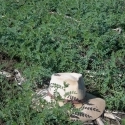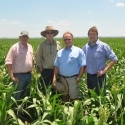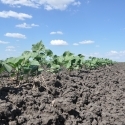04 Mar 2015
K response in wheat
Results from Chelmsford experiment.
 Wheat plots with added K
Wheat plots with added K
A new experiment was initiated at Chelmsford (near Kingroy) in 2014. This experiment again banded P and K compared to an unfertilized control, and compared 4 rates of K (O, 25, 50 and 100) where 40 kg P/ha applied. It also compared the response of 100 kg K/ha where P was present or absent. There was no rain at the site from planting until grain filling, and only 20 mm during the whole cropping season, and despite this very good yields were achieved. The results of this are shown in Figure 2.
Where 100 kg K/ha alone was deep banded, there was a 0.3 t/ha yield increase, but where there was adequate P, the response was 0.6 t/ha, so that the response to K was dependant on have adequate P available. The highest yields occurred where 50 kg K/ha and 40 kg P/ha were supplied, and there was a good response curve to added K. The addition of P stimulates root growth and proliferation and somewhat reduces the response to added K probably because a more vigorous root system is better able to forage for soil K.
Figure 2. The response of wheat to K up to 100 kg/ha, with and without 40 kg P/ha at Chelmsford, Queensland.
Table 1. Effect of added P and/or K on P and K uptake in wheat biomass.
Table 1 shows the P and K uptakes by the wheat crop at maturity and shows that K was accessed around 20 kg K from the banded fertilizer. The uptake of P and its interaction with K is less clear, as the data do not show consistent trends.






